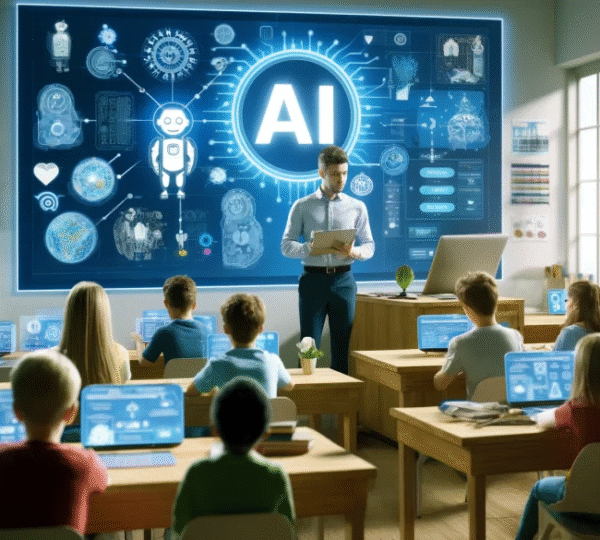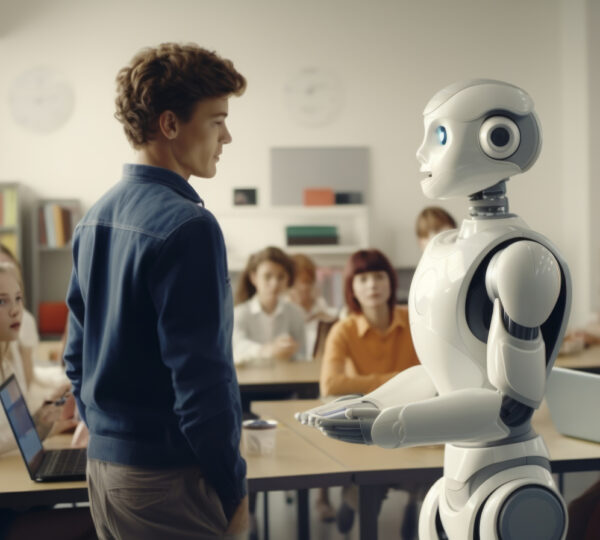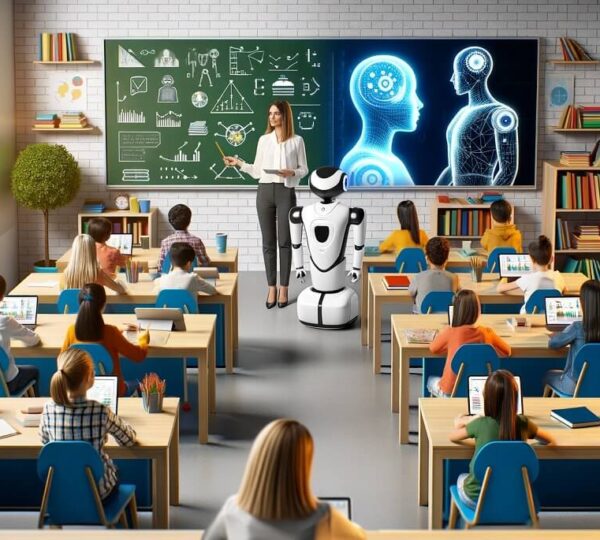Introduction
In the past decade, Artificial Intelligence AI has made significant strides across various industries, and education is no exception. As we look toward the future, AI is expected to play a pivotal role in transforming classrooms, enhancing learning experiences, and addressing educational challenges. From personalized learning to automated grading systems, AI in education is already reshaping the way we teach and learn.
As schools and universities continue to incorporate AI technologies into their curricula, the classroom of the future will look vastly different from today. But what exactly does this future hold, and how will AI help bridge the gap between traditional teaching methods and the modern needs of learners?
This article explores the impact of AI on education, its benefits, potential challenges, and how it will shape learning environments in the years to come.

Understanding AI in Education
What is AI in Education?
AI in education refers to the use of intelligent software and machine learning algorithms to enhance teaching and learning processes. It can range from simple automation tools, like grading systems, to more advanced systems that adapt learning content to suit individual student needs. The core idea behind AI in education is to create an environment where learning is more personalized, efficient, and scalable.
AI powered systems analyze vast amounts of data from students interactions and performance, adjusting learning materials, activities, and assessments in real-time to suit the individual needs of each learner. For example, adaptive learning technologies can adjust the pace and complexity of a lesson based on the learner’s proficiency level.
Key Components of AI in Education
- Machine Learning ML: Machine learning enables systems to learn from data without being explicitly programmed. In education, ML models analyze students learning behaviors and performance data to recommend personalized learning paths.
- Natural Language Processing NLP: NLP allows AI systems to understand and interact with human language. It can be used for applications like automated essay grading, language translation, and providing real time feedback.
- Robotic Process Automation RPA: RPA can automate administrative tasks such as scheduling, reporting, and grading. This frees up educators to focus more on teaching and student interaction.
- Intelligent Tutoring Systems ITS: ITS uses AI to provide real time, personalized feedback to students, acting as a virtual tutor. These systems can identify gaps in knowledge and suggest targeted exercises to reinforce learning.
How AI is Revolutionizing the Classroom
Personalized Learning Experiences
One of the most significant benefits of AI in education is its ability to deliver personalized learning. Traditional classrooms, where all students follow the same curriculum at the same pace, often fail to cater to individual learning speeds and styles. AI, however, can help create a customized learning experience for every student by:
- Assessing individual progress: AI can continuously track a student’s progress and adjust content in real time to suit their pace and proficiency level.
- Offering real-time feedback: By analyzing students answers and behaviors, AI can provide instant feedback, ensuring that learners understand concepts before moving on to the next topic.
- Facilitating diverse learning styles: AI can support visual, auditory, and kinesthetic learners by presenting content in various formats, such as videos, simulations, and interactive exercises.
Example: Adaptive learning platforms like DreamBox and Knewton use AI algorithms to assess student performance and customize the learning experience in real-time.
AI Powered Assessment and Feedback Systems
AI has the potential to significantly streamline assessments and grading systems. Traditional grading methods can be time consuming and prone to human error, especially when dealing with large numbers of students. AI powered systems can:
- Grade assignments automatically: AI can evaluate multiple choice questions, essays, and even short answers with speed and accuracy, providing instant results.
- Offer personalized feedback: Through machine learning, AI can analyze students mistakes and provide specific feedback to help them improve, rather than just awarding a grade.
- Identify learning gaps: AI tools can identify patterns in a students mistakes and recommend resources to help them address those specific gaps in knowledge.
Example: Platforms like Turnitin use AI to detect plagiarism and provide feedback on writing quality, helping students learn from their mistakes.
Support for Teachers and Educators
While AI has the potential to revolutionize education, it also plays a crucial role in supporting teachers. Rather than replacing educators, AI systems help enhance teaching practices by automating administrative tasks and providing insights into student progress. Some key areas where AI supports educators include:
- Automating administrative tasks: AI can handle tasks such as scheduling, attendance tracking, and grading.
- Data driven insights: AI systems can analyze vast amounts of student data to identify trends and patterns, providing teachers with actionable insights to adjust their teaching methods.
- Professional development: AI powered systems can offer personalized training to teachers, suggesting resources, teaching methods, and even classroom management strategies based on their performance and student needs.
Enhanced Student Engagement and Motivation
AI also brings the potential for increased student engagement. With the help of gamification, immersive technologies, and interactive simulations, students are more likely to stay engaged with the learning material. AI can integrate these techniques into lessons by:
- Incorporating gamified elements: AI can turn learning into an interactive game, where students complete challenges and earn rewards based on their progress.
- Simulating real world scenarios: AI powered simulations allow students to experience virtual environments that replicate real world problems, fostering a deeper understanding of the material.
Example: Platforms like Classcraft incorporate gamification to turn classroom behavior and learning into a game, with students earning points for participation and collaboration.

Potential Challenges of AI in Education
Data Privacy and Security
With AI systems continuously collecting and analyzing student data, there are concerns regarding data privacy and security. Protecting students personal and academic information is critical to ensuring the safe implementation of AI in schools. Stricter regulations and ethical guidelines are required to safeguard sensitive information.
Teacher Student Relationship
While AI can enhance the learning experience, it is unlikely to replace the human element in education. The teacher student relationship plays a significant role in student motivation, emotional support, and social learning. AI should complement, rather than replace, this dynamic.
Equity and Accessibility
Access to AI powered tools and resources can be uneven, especially in underfunded schools or regions with limited technological infrastructure. Ensuring that all students have access to these innovations is essential for achieving educational equity.

The Future of AI in Education
As we look toward the future, AI in education will continue to evolve and expand its role. Here are a few emerging trends:
- AI Driven Virtual Classrooms: With advancements in augmented reality AR and virtual reality VR, we can expect AI powered virtual classrooms where students engage in immersive learning experiences, regardless of geographical location.
- Lifelong Learning: AI will make continuous learning more accessible by providing personalized learning paths that adapt to students needs at any age, promoting lifelong education.
- Collaborative AI Tools: AI will enable collaborative learning, where students can work together on projects, share resources, and receive real-time feedback from both their peers and AI tutors.
How is AI used in education?
AI in education is used for personalized learning, automated grading, and intelligent tutoring systems to enhance the learning experience.
What is personalized learning with AI?
AI customizes learning materials and pace according to each student needs, improving engagement and understanding.
How does AI improve grading systems?
AI automates grading for multiple choice tests, essays, and provides instant feedback, saving teachers time and ensuring consistency.
Can AI replace teachers in the classroom?
No, AI enhances the learning process but cannot replace the human element that teachers provide, such as emotional support and motivation.
What is an intelligent tutoring system?
An ITS is an AI powered platform that provides real time feedback and helps students with personalized lessons based on their performance.
Does AI help students with special needs?
Yes, AI offers adaptive learning tools that cater to students with learning disabilities, providing a customized pace and content.
What role does AI play in student assessments?
AI helps in automated assessments, analyzing data to identify gaps in knowledge and suggest improvement areas for students.
How does AI benefit teachers?
AI helps automate administrative tasks, analyze student performance, and provides teaching insights, allowing teachers to focus on quality instruction.
Are AI powered classrooms accessible to all students?
AI tools are growing in accessibility, but there are challenges in ensuring equitable access, particularly in underfunded schools.
What is the future of AI in education?
The future includes AI driven virtual classrooms, lifelong learning opportunities, and collaborative learning tools that adapt to individual needs.
Conclusion
AI is undoubtedly reshaping the landscape of education, offering personalized learning experiences, better assessments, and greater support for both students and educators. However, the integration of AI into education must be approached carefully, balancing its benefits with considerations of data privacy, equity, and the irreplaceable value of human interaction.
As AI continues to evolve, the classroom of the future will be one where technology and human potential work hand in hand to create smarter, more effective learning environments for all students. Embracing AI potential in education could very well be the key to unlocking a new era of personalized, accessible, and engaging learning experiences.

